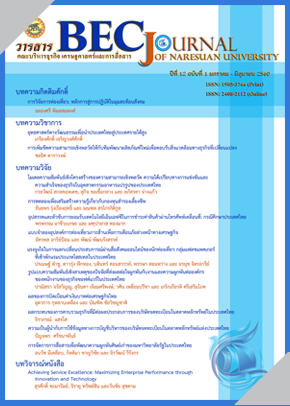แรงจูงใจในการแลกเปลี่ยนประสบการณ์ผ่านสื่อสังคมออนไลน์ของนักท่องเที่ยวกลุ่มแฟลชแพคเกอร์ที่เข้าพักแรมประเภทโฮสเทลในประเทศไทย
Main Article Content
บทคัดย่อ
การวิจัยในครั้งนี้มีวัตถุประสงค์ 1. เพื่อศึกษาพฤติกรรมการใช้ สื่อสังคมออนไลน์ของนักท่องเที่ยวกลุ่ม Flashpacker ที่เข้าพักแรมประเภท Hostel ในประเทศไทย 2. เพื่อศึกษาปัจจัยด้านแรงจูงใจในการแลกเปลี่ยนประสบการณ์ของนักท่องเที่ยวผ่านสังคมออนไลน์กลุ่ม Flashpacker ที่เข้าพักแรม ประเภท Hostel ในประเทศไทย กลุ่มตัวอย่างที่ใช้ในการศึกษา คือนักท่องเที่ยวชาวต่างชาติที่เดินทางท่องเที่ยวและเข้าพักแรมประเภท Hostel จำนวน 400 คน โดยใช้เทคนิคการสุ่มแบบแบบหลายขั้นตอน (Multi - Stage Sampling) เครื่องมือที่ใช้คือ แบบสอบถาม สถิติที่ใช้เป็นสถิติเชิงพรรณา ซึ่งพบว่า นักท่องเที่ยวส่วนใหญ่ให้ความสำคัญมากที่สุดกับแรงจูงใจจากความรู้ของแต่ละบุคคล (Individual action and Personal cognition) โดยนักท่องเที่ยวให้ความสำคัญว่า สมาชิกคิดอย่างไรกับข้อมูลที่ใช้ในการแลกเปลี่ยนบนสื่อสังคมออนไลน์
Article Details
เอกสารอ้างอิง
2. Baym, N. and Boyd, D. (2010). Socially mediated publicness: An introduction. Journal of Broadcasting and Electronic Media, 56(3), 320-329.
3. Boztug, Y., Babakhani, N., Laesser, N. and Dolnicar, S. (2015). The hybrid tourist. Annals of Tourism Research, 54(1), 190–203.
4. Brochado, A., Rita, P. and Gameiro, C. (2015). Exploring backpackers’ perceptions of the hostel service quality. International Journal of Contemporary Hospitality Management, 27(8), 1839-1855.
5. Buhalis, D. and O’ Connor, P. (2005). Information communication technology revolutionizing tourism. Tourism recreation research, 30(3), 7-16.
6. Cochran, W. (1977). Sampling techniques (3rd). USA: John Wiley and son.
7. Cheung, C. and Thadani, D. (2012). The impact of electronic word-of-mouth communication:
A literature analysis and integrative model. Decision Support Systems, 54(1), 461–470.
8. Cooper, M. (2006). Redefining young low cost travellers - still backpackers or are they budget travellers?. Euro Asia Journal of Management, 16 (2), 137-151.
9. Dabphet, S. (2015). Tourism in national capitals and global change. Journal of Business, Economics and Communications, 10(1), 120-122.
10. Damchoo, P. (2015). Communication technology for sustainable. Journal of Business, Economics and Communications, 10(2), 167-170.
11. Department of Tourism. (2015). Strategy and strategic for tourism development department of tourism 2014-2017. Retrieved December 1, 2016, from http://tourism2.tourism.go.th/home/details/11/669/2224
12. Gretzel, U. and Yoo, K. H. (2008). What motivates consumers to write online travel reviews?. Information Technology and Tourism. 10(13), 283-295.
13. Hana, S. and John, A. (2012). Social media usage and impact. United Kingdom: Lexington.
14. Hannam, K. and Diekmann, A. (2010). Beyond backpacker tourism: Mobilities and experiences. Canada: Short run press.
15. Hecht, J. and Martin, D. (2006). Backpacking and hostel‐picking: an analysis from Canada. International Journal of Contemporary Hospitality Management, 18(1), 69-77.
16. Hostelworld. (2016). Corporate social responsibility. Retrieved December 15, 2016, from http://www.hostelworldgroup.com/~/media/Files/H/Hostelworld/reports-and-presentations/ar-2015.pdf
17. Huang, S. (2007). The effects of motivation, past experience, perceived constraint, and attitude on tourist revisit intention. Doctoral dissertation, D.B.A., Hong Kong Polytechnic University, Hongkong.
18. Hughes, D. J., Rowe, M., Batey, M. and Lee, A. (2012). A tale of two sites: Twitter vs. Facebook and the personality predictors of social media usage. Computers in Human Behavior, 28(2), 561–569.
19. Jordan, F. (October 15, 2016). Tourism and technology: Revisiting the experiences of women travelling alone. in International Conferences on Information Technology and Business (ICITB) ( Page 1-185). United Kingdom: Excellence in Research and Innovation for Humanity.
20. Marabese, M. (2012). A journey through flashpacking the posh side of the moon or the technopacker evolution. Denmark: Aalborg University.
21. McCulloch, J. (1992). The youth hostels association: precursors and contemporary achievements. The Journal of Tourism Studies, 3(1), 22-27.
22. Minazzi, R. (2015). Social media marketing in tourism and hospitality. Italy: Springer.
23. Ministry of Tourism and Sports. (2015). Tourism Thailand strategy 2015-2017. Retrieved August 15, 2016, from http://www.mots.go.th/ewt_dl_link.php?nid=7114
24. Molz, G. (2012). Tourism today: Interactive travel and the performance of mobile sociality. Germany: Sage.
25. Molz, G. and Paris, M. (2015). The social affordances of flashpacking: exploring the mobility nexus of travel and communication. Journal Mobilities, 10(2), 173-192.
26. Munar, A. and Jacobsen, J. (2014). Motivations for sharing tourism experiences through social media. Tourism Management, 43(1), 46-54.
27. Nash, R., Thyne, M. and Davies, S. (2006). An investigation into customer satisfaction levels in the budget accommodation sector in Scotland: A case study of backpacker tourists and the Scottish Youth Hostels Association. Tourism Management, 27(3), 525–532.
28. O’Regan, M. (2008). Hypermobility in backpacker lifestyles: The emergence of the internet café. CAB International, 51(1). 109-132.
29. Paris, M. (2010). Understanding the virtualization of the backpacker culture and the emergence of the flashpacker: A mixed-method approach. Doctoral dissertation, Ph.D., Arizona State University, USA.
30. Paris, M. (2011). Flashpackers: An emerging Sub-Culture?. Annals of Tourism Research, 39(2), 1094-1115.
31. Paris, M. (January, 24-27, 2012). Flashpacking: A Discussion of independent travel in a digital world. in Information and Communication Technologies in Tourism 2012: Proceedings of the International Conference in Helsingborg (Page 1-175). Sweden: Springer.
32. Pavelka, J. (2016). Smartphone use during travel. Travel and tourism research association, 18(5), 88-104.
33. Perez, R. and Spiegelman, E. (2008). Why do people tell the truth? Experimental evidence for pure lie aversion. A Journal of the Economic Science Association, 16(3), 233-247.
34. Qu, H. and Lee, H. (2011). Travelers’ social identification and membership behaviors in online travel community. Tourism Management, 32(6), 1262-1270.
35. Richard, G., Tiffany, L. and Wyatt, V. (2009). A long-duration (118-day) backpacking trip (2669 km) normalizes lipids without medication: A case study. Wilderness Medical Society, 20(4), 347-352.
36. Somlai, R. (2015). The influence of ratings on choosing accommodation. Sociology Study, 5(4), 282-290.
37. Taskov, N., Dimitrov, N. and Metodijeski, M. (15 May 2014). A review of the hostel sector in the republic of macedonia. in International Practical - Scientific Conference: Tourism Economics and Business (Page 1-262). Batumi Shota Rustaveli: State University.
38. Vaals, F. (2013). The future of backpacking. Journal of Intern at the European Tourism Futures Institute, 7(1), 1-28.
39. Vasko, M. and Abrham, J. (2015). Issues of secure and sustainable e-tourism: Case of the Czech Republic. Journal of Security and sustainability issues, 5(2), 137-148.
40. Xiang, Z., Gretzel, U. and Fesenmaier, D. (2009). Semantic representation of tourism on the internet. Journal of Travel Research, 47(4), 440-453.
41. World Tourism Organization. (2013). Regional tourism satellite account. Retrieved December 11, 2016, from http://cf.cdn.unwto.org/sites/all/files/IP_RTSA_EN.pdf


